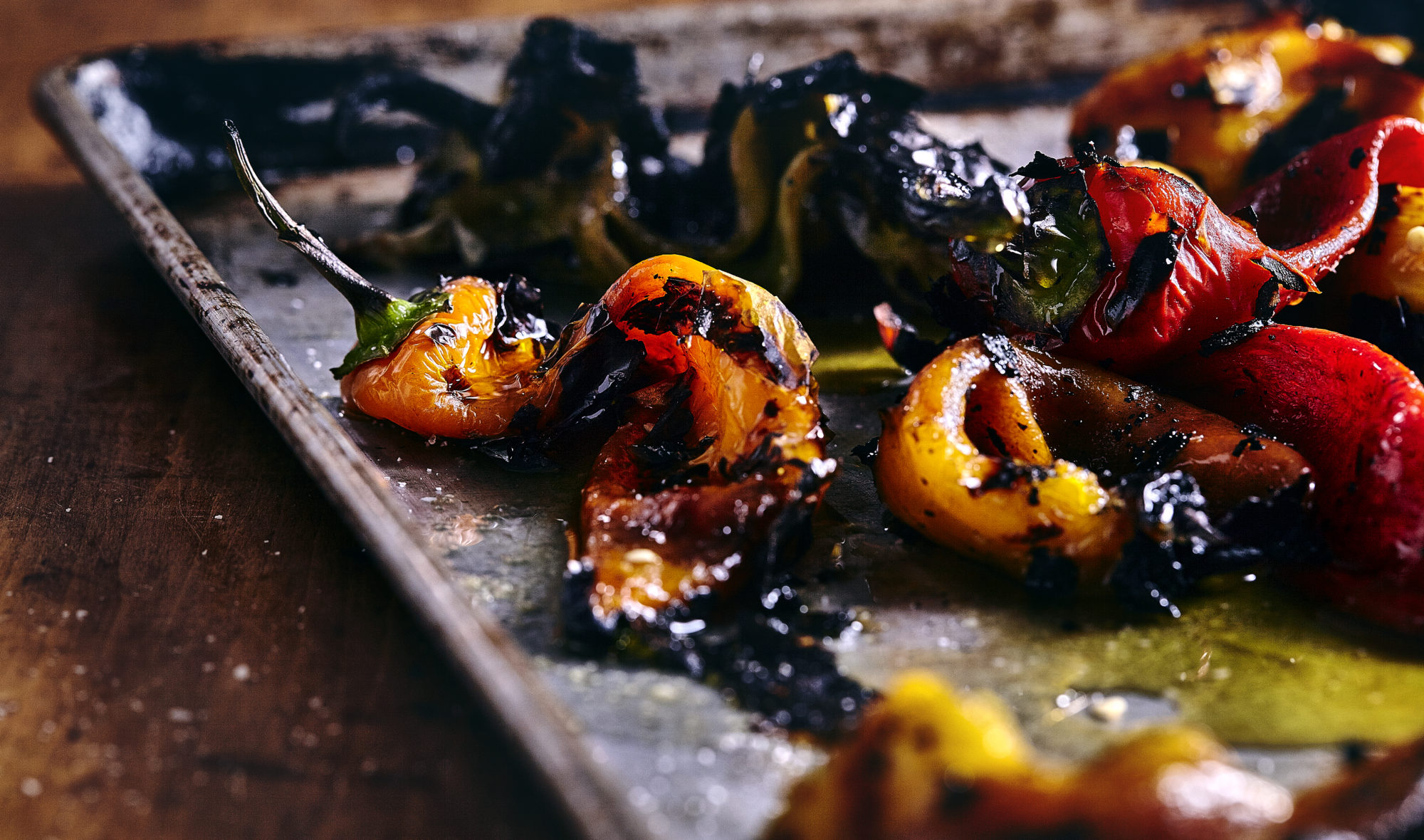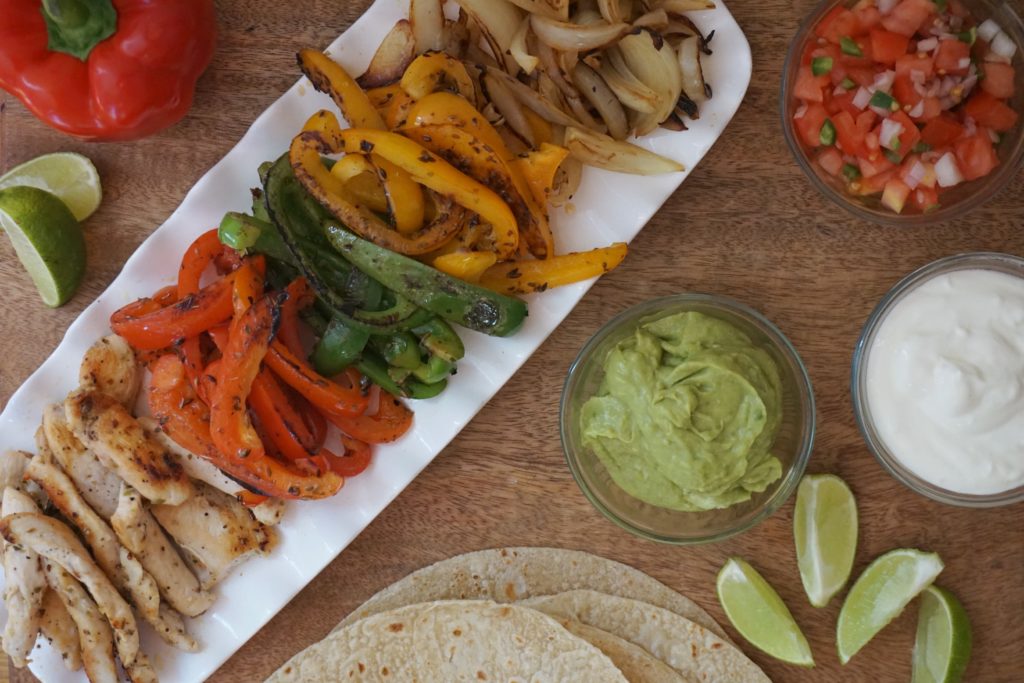
Bell peppers, also known as sweet peppers, come in a rainbow of vivid colors: green, red, orange, yellow, lavender, chocolate brown, and cream. Although technically a fruit, peppers, like tomatoes and avocados, often fall under the vegetable umbrella in culinary taxonomy. In flavor, bell peppers differ from many other members of the pepper family; instead of a spicy heat, a fruity sweetness is the dominating flavor. Flavor will vary depending on the color of the bell pepper, with the red, orange, yellow, brown, and cream varieties being the sweetest, and the green and purple varieties being slightly more bitter. Nutritional properties will also vary by color: while all varieties are rich in vitamin C, red, orange, and yellow toned bell peppers will be uniquely high in carotenoids, which are compounds in the vitamin A family. Happily, all varieties are delightfully crispy.
Also known as sweet pepper, this plant comes in a rainbow of colors: red, green, yellow, orange, and less commonly seen, lavender, chocolate brown, and cream. Botanically, bell peppers are actually fruits although, like tomatoes and avocados, they are generally thought of as vegetables.
The most popular variety of bell pepper is the green pepper, which is often just an immature, unripened version of the other colored varieties. However, this is not always the case. Some bell peppers stay green when fully ripened, and not all bell peppers start out green.
Unlike many members of the pepper family, bell peppers are not spicy. The heat that comes from spicy peppers is caused by a compound called capsaicin, which is found in tiny amounts in bell peppers, compared to the massive amounts found in, for example, the Carolina Reaper pepper, which currently holds the throne for the world’s hottest pepper.
Bell peppers have been cultivated for over 9000 years, with its origins rooted in Central and South America. Today, China is the world’s top producer of peppers, followed by Mexico.
As mentioned, bell peppers come in a variety of glossy colors: red, green, yellow, orange, purple, dark brown, and cream.
The bell pepper is composed of three or four bulging lobes fused together, tapering slightly at the bottom and topped with a coarse green stem at the top. Inside the pepper, you will find a cluster of small white seeds towards the stem end. Although these seeds are edible, they are typically discarded because they are slightly bitter.
All varieties of bell pepper are satisfyingly crispy, although they do vary slightly in flavor depending on their color. Red, yellow, orange, chocolate, and cream bell peppers are sweet and almost fruity tasting, whereas green and purple bell peppers are slightly more bitter and grassier tasting.
One medium-sized red bell pepper (about 119g) has 37 calories, 1.2g protein, 0.4g of fat, 7.2g of carbohydrates, 2.5g fiber, and 5g sugar. Bell peppers are an excellent source of vitamin C, and the red, orange, and yellow toned varieties are a good source of carotenoids like alpha-carotene, beta-carotene, cryptoxanthin, lutein, and zeaxanthin, which are compounds in the vitamin A family.
Peppers are widely available at most grocery stores and fruit and vegetable markets. Although peppers are usually available from imports year-round, they will likely be tastiest in North America when in season, which is in the summer and early fall.
Choose peppers that are heavy for their size and have taut, glossy, firm skin with a fresh-looking green stem. If you find peppers that are soft, wrinkled, or have dark spots, pass them over.
No matter the color variety you choose, select peppers with vivid colors, as this will usually reflect optimal ripeness and flavor.
Bell peppers that are purchased when optimally ripe can be kept in the fridge for seven to ten days. If you suspect that your pepper is not fully ripe when you buy it, you may want to keep it outside of the fridge for two to three days while it matures.
Bell peppers are sensitive to moisture loss, and this loss of water and turgidity can be exacerbated if the pepper is cut, or if the stem is removed. Therefore, in order to preserve maximum crispness, store your peppers whole and with the stem intact.
Bell peppers can also be frozen; store them whole or cut in an airtight container for up to six months.
Bell peppers are delicious both raw and cooked. The simplest way to eat them is to slice them and eat them raw, or to throw them in a pan and sauté them lightly. They are also delicious grilled or even stuffed and roasted.
In order to eat a pepper, wash it under cool running water, and then slice it (lengthwise) in half. This will reveal a cross-section of pale membranes and seeds, which may be carved out along with the stem and discarded. Both the membranes and the seeds are edible, but the seeds, in particular, are often tossed because they are bitter tasting.
The soft membranes are inoffensive and sometimes kept on, depending on personal preferences. After washing and carving out the bits you don’t want to eat, you may cut the bell pepper in desired shapes and either eat them as-is, or add them to a dish of your choice.

Fajita night, like taco night or make-your-own pizza night, is a fun occasion that the whole family can enjoy. Fajitas are built in a choose-your-own-adventure style and are incredibly versatile and easy to make.
Prep Time: 20 minutes Cook Time: 20 minutes Yield: 4 servings
In a large skillet, heat 1 tablespoon of oil over high heat. Wait until pan is hot enough that a fleck of water sizzles upon contact, and then add the onions. Spread the onions over the pan, but don’t stir them immediately, and instead wait until they start to char a little bit. Then, stir to toss. Again, leave the onions to char slightly before moving them around. Repeat a few times, until the onions are slightly soft and nicely charred at the edges. Remove onions from the pan and set aside.
Using the same skillet, add 2 tablespoons of oil and place over high heat. Again, wait until the pan is hot enough that water sizzles upon contact before adding the pepper slices. Add the peppers, cumin seeds, and dried oregano, and toss to coat. Then, allow mixture to sit in the pan without stirring until a char develops on one edge, like the above method. Repeat until the peppers are slightly softened but still brightly colored, with a slight char at the edges.
Place cooked onions, peppers, and chicken (or your choice of protein) on a platter and serve family-style with tortillas, pico de gallo, Greek yogurt or sour cream, guacamole, and sliced limes.
Fajitas are a choose-your-own-adventure dish. We suggest starting with a tortilla wrap, and then adding charred peppers, onions, and chicken, topping with guacamole and Greek yogurt, and finishing with a squeeze of fresh lime. Season with salt and pepper according to taste, and have fun!
Precision Nutrition’s Encyclopedia of Food expands every single month as we highlight new foods and showcase beautiful food photography. If you’d like to stay up to date, simply click this link. From there, we’ll send you a FREE copy of our recipe book. We’ll also let you know when new and delicious foods are added to the site.
Bell peppers, also known as sweet peppers, come in a rainbow of vivid colors: green, red, orange, yellow, lavender, chocolate brown, and cream. Although technically a fruit, peppers, like tomatoes and avocados, often fall under the vegetable umbrella in culinary taxonomy. In flavor, bell peppers differ from many other members of the pepper family; instead of a spicy heat, a fruity sweetness is the dominating flavor. Flavor will vary depending on the color of the bell pepper, with the red, orange, yellow, brown, and cream varieties being the sweetest, and the green and purple varieties being slightly more bitter. Nutritional properties will also vary by color: while all varieties are rich in vitamin C, red, orange, and yellow toned bell peppers will be uniquely high in carotenoids, which are compounds in the vitamin A family. Happily, all varieties are delightfully crispy.